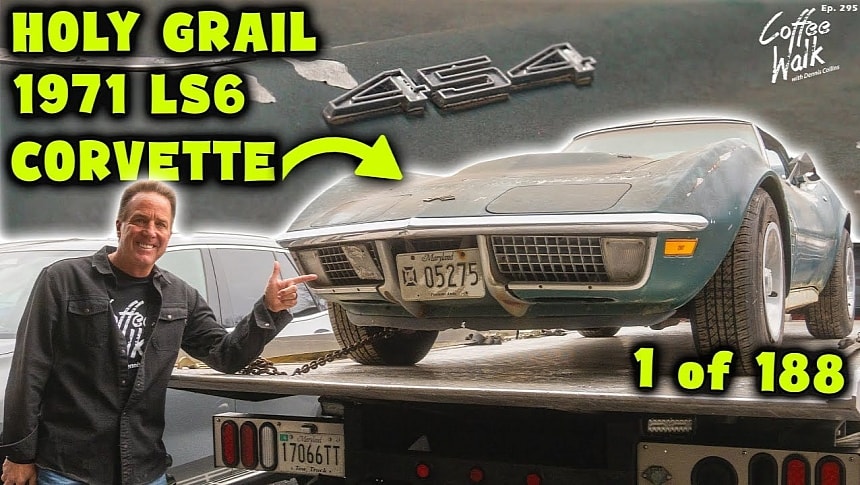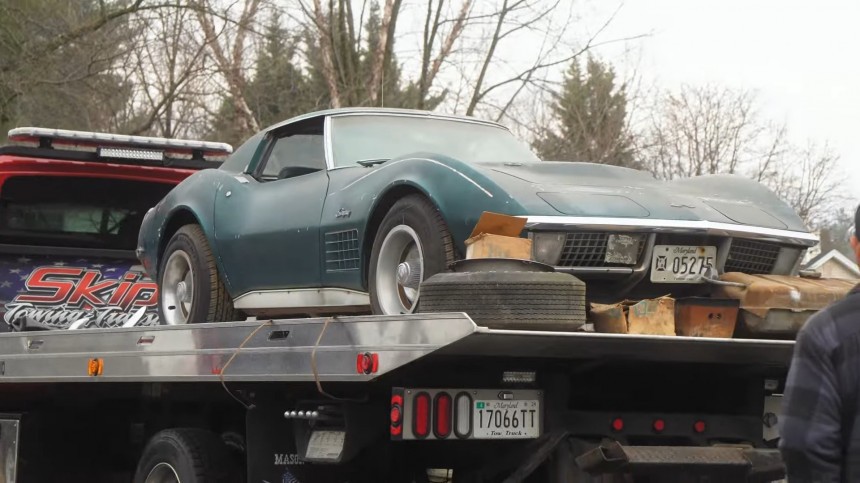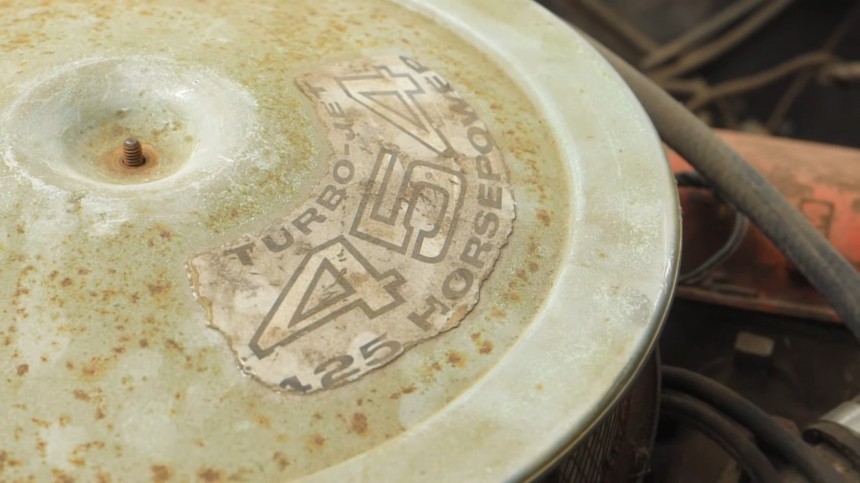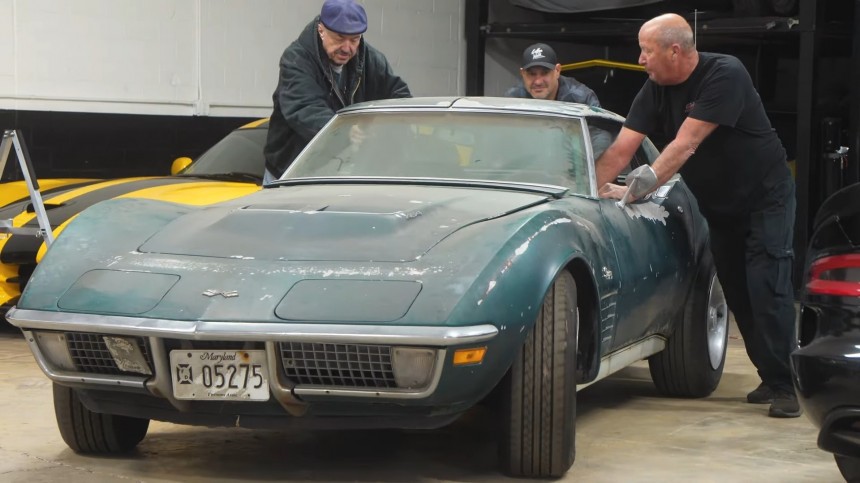1971 was not one for the graduation albums of anyone in Detroit. Big and small automakers were served the low-compression-only course from the federal government. Basically, lead and gasoline could no longer live together in the same combustion chamber, so the metal was evicted. The toxic metal prevented premature combustion in high-compression engines running on high-octane fuels. The ban eradicated performance – from that moment on, the horsepower wars became a thing of the nostalgic past.
1971 was the last year for the HEMI, and that alone should put the big picture into frame. However, there was one last stand of piston muscle, one mutiny against anemic engines – and who better to make the final charge than America’s sportscar? The Corvette didn’t want to go down without a fight, even if the rules of the game said the game was over.
In 1970, GM had finally relented from the self-imposed cubic-inch-per-GVWR it had enforced on its divisions since 1963. It signaled the motor mayhem, with Chevrolet, Pontiac, Oldsmobile, and Buick throwing some monsters into the horsepower and torque arena. The numbers are legendary: 454 and a trio of 455s, all wearing the General Motors seal of approval. Among them, the Chevy Big-Block 454 was the absolute and unrivaled apex predator, with 450 hp in the LS6 Chevelle SS.
One year later, it was pretty much clear that the muscle car era had just come to an abrupt end. All manufacturers started revising the performance figures, except Chevrolet. Due to several reasons, 1970 saw a break away from the tradition that obliged the Corvette to be at the forefront of the horsepower ratings. The Chevelle claimed the throne, leaving the Corvette behind.
The reason was that the LS7 engine that was in the wraps for the ’70 Corvette was never released. It should have been a 460-hp atrocity, but the stars simply refused to align. The LS6 went down in history as the Chevelle aura of immortality. What is less known is that the motor did see action in 1971, too – in the Corvette. In 188 sportscars, to be precise – albeit with a slightly lowered output. Instead of the competition-crushing 450 hp of 1970, the 1971 version of the big-block V8 fired ‘only’ 425 hp.
It was right on par with the Street HEMI, and the 475 lb-ft of torque (644 Nm) made it a real tire vaporizer. Add a 4:11 rear axle (with positive traction, of course) and a dual-disc clutch for the M22 Rock Crusher Muncie four-speed manual, and the Corvette suddenly became a super-weapon. Sadly, it backfired horrendously since the oversized ogre was guzzling gas like there was no tomorrow (and there wasn’t).
The rated mileage ranged between 9 to 14 mpg (26 l/100 km and 17 l/100 km). Remember, the oil embargo was still two years into the future, but those numbers were appalling nonetheless. That’s why only 188 examples of the 1971 Corvette came with the infamously detuned 454-cubic-inch (7.4-liter) LS6 engine. Even if the 9.0:1 compression wasn’t every bit as much of a kicker compared to those of the previous years’ most performant GM powerhouses, the price was its biggest deterrent.
The compression ratio on the Chevelle motor was 11.25:1; both motors had the same short block, but the Corvette used the open-chamber aluminum heads from the late ‘69 L88 Corvette engine. The 1970 LS6 used closed-chamber iron heads. So, the 1971 Corvette was the final bow regarding factory performance offerings. It was a one-year-only undertaking that wasn’t even attracting customers anymore, despite its 0-60 mph GPA of 5.3 seconds, only three-tenths behind LS6 Chevelle from the previous year.
The raised eyebrows triggered by the ‘wasn’t attracting customers’ deserve an answer, and I won’t give it to them. But Dennis Collins has found one 1971 LS6 Corvette that will attest to that statement. The car sat for two years in the dealer’s showroom, and when it was finally bought, the 454’s block cracked open.
Due to the terms of the warranty, the motor was repaired – a CE bottom end is now sitting under the big aluminum heads. To qualify for Counter Exchange (that’s what the ‘C’ and ‘E’ cast on the block stand for), the client had to leave the blown-up parts behind so that General Motors could inspect what went wrong.
This particular car was sold new in Fredericks, Maryland, and has had two owners since new and the first one kept the car outside, unprotected and unguarded, for many years before selling it to the man in the video below. The 4.11 gearing in the rear diff didn’t please the car nut much, so he replaced it with a speed-chasing 3.31. No other mods were performed on this rarity – unless we count the removal of the chrome bumpers, the mufflers, and the gas tank (but these parts are still with the car).
Despite their rarity and inherent historical value, the 1971 LS6 Corvettes aren’t a treasure trove for car nuts – unlike an original HEMI ‘Cuda or an SS Impala 409. The most expensive example sold publicly topped out at $214,500 in January of last year, and the market average for these unicorns is a mere $150,000 (and all of them were in far better shape than this survivor).
In 1970, GM had finally relented from the self-imposed cubic-inch-per-GVWR it had enforced on its divisions since 1963. It signaled the motor mayhem, with Chevrolet, Pontiac, Oldsmobile, and Buick throwing some monsters into the horsepower and torque arena. The numbers are legendary: 454 and a trio of 455s, all wearing the General Motors seal of approval. Among them, the Chevy Big-Block 454 was the absolute and unrivaled apex predator, with 450 hp in the LS6 Chevelle SS.
One year later, it was pretty much clear that the muscle car era had just come to an abrupt end. All manufacturers started revising the performance figures, except Chevrolet. Due to several reasons, 1970 saw a break away from the tradition that obliged the Corvette to be at the forefront of the horsepower ratings. The Chevelle claimed the throne, leaving the Corvette behind.
It was right on par with the Street HEMI, and the 475 lb-ft of torque (644 Nm) made it a real tire vaporizer. Add a 4:11 rear axle (with positive traction, of course) and a dual-disc clutch for the M22 Rock Crusher Muncie four-speed manual, and the Corvette suddenly became a super-weapon. Sadly, it backfired horrendously since the oversized ogre was guzzling gas like there was no tomorrow (and there wasn’t).
The rated mileage ranged between 9 to 14 mpg (26 l/100 km and 17 l/100 km). Remember, the oil embargo was still two years into the future, but those numbers were appalling nonetheless. That’s why only 188 examples of the 1971 Corvette came with the infamously detuned 454-cubic-inch (7.4-liter) LS6 engine. Even if the 9.0:1 compression wasn’t every bit as much of a kicker compared to those of the previous years’ most performant GM powerhouses, the price was its biggest deterrent.
The raised eyebrows triggered by the ‘wasn’t attracting customers’ deserve an answer, and I won’t give it to them. But Dennis Collins has found one 1971 LS6 Corvette that will attest to that statement. The car sat for two years in the dealer’s showroom, and when it was finally bought, the 454’s block cracked open.
Due to the terms of the warranty, the motor was repaired – a CE bottom end is now sitting under the big aluminum heads. To qualify for Counter Exchange (that’s what the ‘C’ and ‘E’ cast on the block stand for), the client had to leave the blown-up parts behind so that General Motors could inspect what went wrong.
Despite their rarity and inherent historical value, the 1971 LS6 Corvettes aren’t a treasure trove for car nuts – unlike an original HEMI ‘Cuda or an SS Impala 409. The most expensive example sold publicly topped out at $214,500 in January of last year, and the market average for these unicorns is a mere $150,000 (and all of them were in far better shape than this survivor).









































